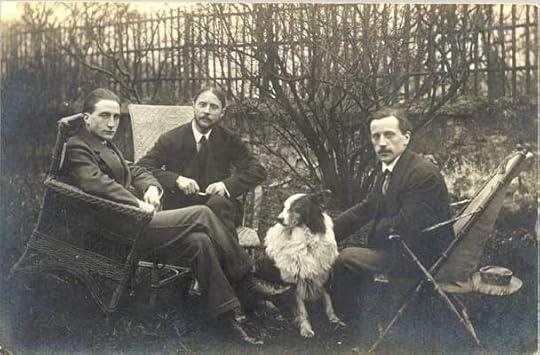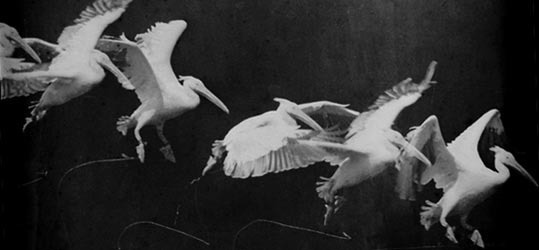Art Lovers discussion
Art History
>
Art News for this Day in History
date newest »
newest »
 newest »
newest »
message 101:
by
Carol
(new)
Feb 01, 2012 03:54PM
 Thanks Monica for your post about the PBS American Masters film on Stieglitz "The Eloquent Eye." I never heard of this series! I just picked it up from the library. I had read Georgia's biography so it was interesting to see his side of their story plus that Georgia was able to be interviewed, I think she was only in her 80s in the film. I felt bad for his first wife, he basically did what he wanted to do, I think he only married her because of family and also her money. Even though he was a difficult person to get along with, he brought Modernism to NYC and personally I love his photography.
Thanks Monica for your post about the PBS American Masters film on Stieglitz "The Eloquent Eye." I never heard of this series! I just picked it up from the library. I had read Georgia's biography so it was interesting to see his side of their story plus that Georgia was able to be interviewed, I think she was only in her 80s in the film. I felt bad for his first wife, he basically did what he wanted to do, I think he only married her because of family and also her money. Even though he was a difficult person to get along with, he brought Modernism to NYC and personally I love his photography.
reply
|
flag
 I love Stieglitz's photography, too. I mix his name up with Steichen. Was it you who posted the pic of Steglitz with his firs wife, Marin and some other friends in the woods in Mt. Kisco? Georgia's flower paintings were (are) incredible. I remember being in the attic in the Met when I was participating in an art series in high school and was totally gobsmacked when they pulled out a rack and one of her black and white flower paintings was there. Why was it not on view? Back then all modern art was displayed at MOMA. I remember O'Keefe while she was alive and so the American Masters series made me recognize how much time has passed. IIRC there was a full TV documentary on O'Keefe and the footage used was from that documentary. Stieglitz didn't need his first wife's money. Who knows what pressure he was under to conform? O'Keefe made it clear she didn't care if they got married but they certainly made news. It reminds me of Johnny Cash and June Carter. It was a very sad time for his first wife and their children but obviously the artistic match couldn't be denied and I bet, like Cash, Steglitz's marriage was pretty much over by the time he moved in with O'Keefe.
I love Stieglitz's photography, too. I mix his name up with Steichen. Was it you who posted the pic of Steglitz with his firs wife, Marin and some other friends in the woods in Mt. Kisco? Georgia's flower paintings were (are) incredible. I remember being in the attic in the Met when I was participating in an art series in high school and was totally gobsmacked when they pulled out a rack and one of her black and white flower paintings was there. Why was it not on view? Back then all modern art was displayed at MOMA. I remember O'Keefe while she was alive and so the American Masters series made me recognize how much time has passed. IIRC there was a full TV documentary on O'Keefe and the footage used was from that documentary. Stieglitz didn't need his first wife's money. Who knows what pressure he was under to conform? O'Keefe made it clear she didn't care if they got married but they certainly made news. It reminds me of Johnny Cash and June Carter. It was a very sad time for his first wife and their children but obviously the artistic match couldn't be denied and I bet, like Cash, Steglitz's marriage was pretty much over by the time he moved in with O'Keefe.
 Yes I posted the picture of Stieglitz and Marin and others . . . I really love both his photography and her paintings. (I have to admit I did go to MoMA more than I did the MET or other art museums.)
Yes I posted the picture of Stieglitz and Marin and others . . . I really love both his photography and her paintings. (I have to admit I did go to MoMA more than I did the MET or other art museums.) Stieglitz's parents pressured him to settle down and marry Emmeline Obermeyer (sister of his close friend and business associate Joe Obermeyer). She was 20; Stieglitz 29. Stieglitz said that he did not love her and their marriage was not consummated for at least a year. He indicated that their marriage was one of financial advantage for him (she had inherited money from her father, a wealthy brewery owner) at a time when his own father had lost a great deal of money in the stock market. Also throughout his life Stieglitz was infatuated with younger women. (His mom was 12 yrs. younger than his dad, which influenced him.) He regretted his decision to marry because Emmy could not "match his own artistic and cultural interests."
I believe I remember reading in her biography, that O'Keeffe didn't want to get married (in 1924) to Stieglitz. I think she knew that it wouldn't work out because of his ways. But he convinced her. In fact after they married, they got into a car to leave and immediately had an car accident which she saw as a sign. Before they married O'Keeffe expressed to Stieglitz how deeply she wanted to have a baby, since she was 37 (he 60) it was probably her last opportunity, but he wouldn't let her. He wanted her to devote all her time to her art and to him. So she did. Even though she was a "tough cookie," he was in charge.
 HAPPY 125TH BIRTHDAY MARCEL DUCHAMP! This 1911 painting was one of Duchamp's early studies for "Nude Descending a Staircase"
HAPPY 125TH BIRTHDAY MARCEL DUCHAMP! This 1911 painting was one of Duchamp's early studies for "Nude Descending a Staircase" 
This painting, which Marcel Duchamp identified as a self-portrait, was probably begun during December of 1911 in Neuilly, while he was exploring ideas for the controversial Nude Descending a Staircase, No. 2 of 1912. In Nude (Study), Sad Young Man on a Train his transitory though acute interest in Cubism is manifested in the subdued palette, emphasis on the flat surface of the picture plane, and in the subordination of representational fidelity to the demands of the abstract composition.
Duchamp’s primary concern in this painting is the depiction of two movements, that of the train in which we observe the young man smoking and that of the lurching figure itself. The forward motion of the train is suggested by the multiplication of the lines and volumes of the figure, a semitransparent form through which we can see windows, themselves transparent and presumably presenting a blurred, “moving” landscape. The independent sideways motion of the figure is represented by a directionally contrary series of repetitions. These two series of replications suggest the multiple images of chronophotography, which Duchamp acknowledged as an influence, and the related ideas of the Italian Futurists, of which he was at least aware by this time. Here he uses the device not only to illustrate movement, but also to integrate the young man with his murky surroundings, which with his swaying, drooping pose contribute to the air of melancholy. Shortly after the execution of this and similar works, Duchamp lost interest in Cubism and developed his eccentric vocabulary of mechanomorphic elements that foreshadowed aspects of Dada.
Lucy Flint
 Three Duchamp brothers, left to right: Marcel Duchamp, Jacques Villon, and Raymond Duchamp-Villon in the garden of Jacques Villon's studio in Puteaux, France, 1914, (Smithsonian Institution)
Three Duchamp brothers, left to right: Marcel Duchamp, Jacques Villon, and Raymond Duchamp-Villon in the garden of Jacques Villon's studio in Puteaux, France, 1914, (Smithsonian Institution)
Embodying the intellect of his literary contemporaries (Proust and Joyce), Duchamp (1887–1968) has been described by Willem de Kooning as a “one-man movement.” Jasper Johns has written of his work as the "field where language, thought and vision act on one another." Duchamp has had a huge impact on 20th century art. By World War I, he had rejected the work of many of his fellow artists as "retinal" art, intended only to “please the eye”. Instead, Duchamp wanted, he said, "to put art back in the service of the mind." (MET)
The first presentation of the painting was at the Parisian Salon des Indépendants, where it was rejected by the Cubists. It was exhibited at the legendary 1913 Armory Show in New York, where it caused an uproar which both outraged many people and made Duchamp famous in America. One critic called it "an explosion in a shingle factory."
In “Nude descending the Staircase” Duchamp depicts motion by successive superimposed images. Duchamp also recognized the influence of the stop-motion photography of the pioneer of photography and cinema Étienne-Jules Marey (1830-1904). Marey starting by studying blood circulation and later became fascinated with by movements of air and started to study birds in flight. His revolutionary idea was to record several phases of movement on one photographic surface. In 1890 he published Le Vol des Oiseaux (The Flight of Birds), richly illustrated with photographs, drawings, and diagrams.

Flying pelican captured by Marey around 1882.
Duchamp recognized Eadweard Muybridge's (1830-1904) Woman Walking Downstairs from his 1887 picture series, published as The Human Figure in Motion.
http://lb.wikipedia.org/wiki/Fichier:...
moving image: http://commons.wikimedia.org/wiki/Fil...
 Heather wrote: "18 February 1913 French painting Nude Descending a Staircase No.2 (1912) by Marcel Duchamp causes a scandal at the 1913 Armory Show in New York City.
Heather wrote: "18 February 1913 French painting Nude Descending a Staircase No.2 (1912) by Marcel Duchamp causes a scandal at the 1913 Armory Show in New York City. Nude Descending a Staircase
..."
Happy Birthday Marcel Duchamp!
"Love it or hate it, Marcel Duchamp’s Fountain 1917 revolutionised modern art. As a birthday tribute we have put together a selection of artworks by him and by those inspired by him ..."
http://www.tate.org.uk/context-commen...
 Interesting, Ed. No, my distaste for Duchamp has not changed. Sorry, but thank you for enlightening me!
Interesting, Ed. No, my distaste for Duchamp has not changed. Sorry, but thank you for enlightening me!
 Heather wrote: "Interesting, Ed. No, my distaste for Duchamp has not changed. Sorry, but thank you for enlightening me!"
Heather wrote: "Interesting, Ed. No, my distaste for Duchamp has not changed. Sorry, but thank you for enlightening me!"No need to like Duchamp. :)
 Sadly this is they day Vincent van Gogh died.
Sadly this is they day Vincent van Gogh died.(When van Gogh was my age he'd been dead for 26 years!)
Books mentioned in this topic
Van Gogh: The Life (other topics)Michelangelo and the Pope's Ceiling (other topics)
The Aeneid (other topics)



